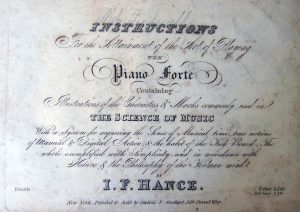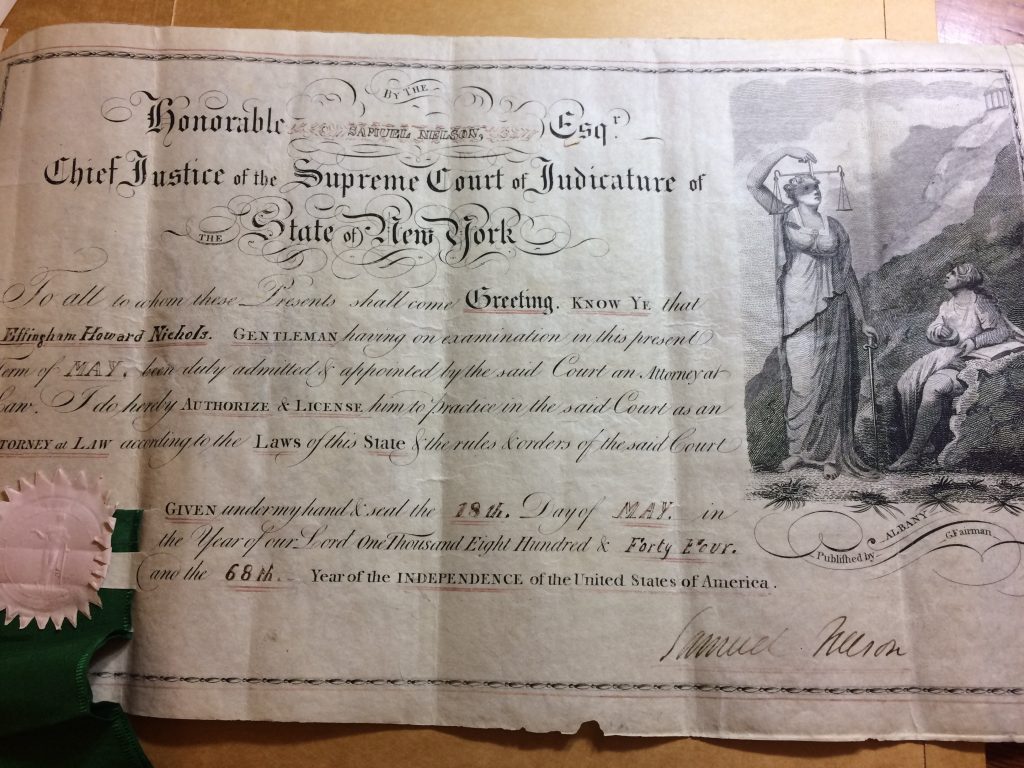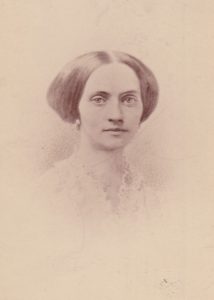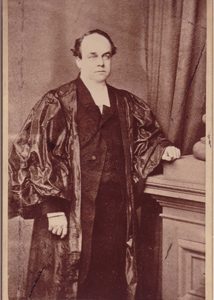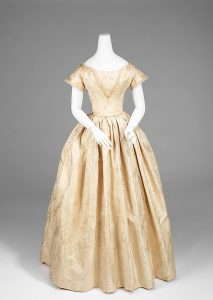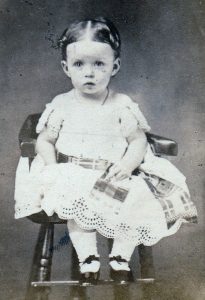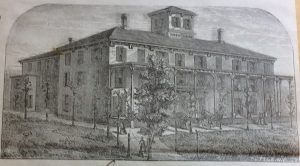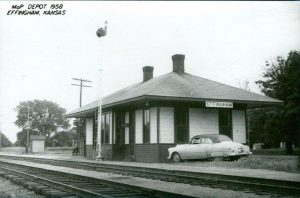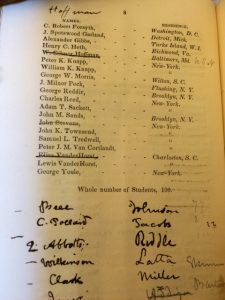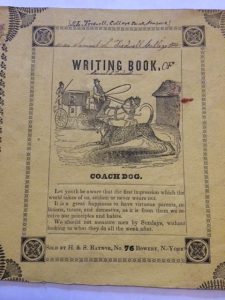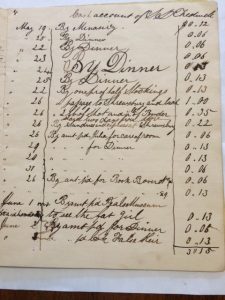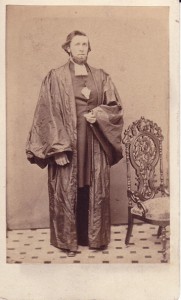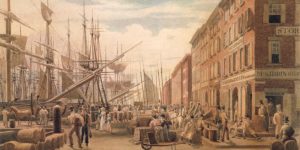“Days of Sorrow, Days of Rejoicing:” Elizabeth Tredwell & Effingham Nichols
by Ann Haddad
Bells Are Ringing!
The magnificent row house on Fourth Street was surely buzzing with excitement on the morning of Wednesday, April 9, 1845, for it marked a Tredwell milestone: the first family wedding! Seabury and Eliza’s eldest child, 23-year-old Elizabeth Seabury, was about to tie the knot.
Born on July 23, 1821, in the Tredwells’ first home at 34 Cedar Street, Elizabeth was baptized on August 18 at St. George’s Chapel, then located at Beekman Street. She, like four of her sisters, attended the fashionably elite Mrs. Okill’s Academy, located at 8-10 Clinton Street (now 8th Street). In addition to the usual academic subjects, Elizabeth was instructed in the French language and in music, two skills considered essential to a young woman’s education. The Tredwell Books Collection contains one of Elizabeth’s music books, Instructions for the Attainment of the Art of Playing the Piano Forte, which was most likely also used by her sisters.
The Nichols Family: An Excellent Lineage
Elizabeth’s “finishing school” education was the preparation for the roles she was predestined to assume within the elite society in which she was raised, that of wife and mother. Meanwhile, the young man to whom she would one day be wed was being educated by a private tutor so that he would follow in his father’s footsteps and attend Yale University.
Effingham Howard Nichols, born on November 17, 1821, was surely considered a suitable match for Elizabeth; he came from a prominent New York family, counting among his ancestors Sir Richard Nichols, the first English Governor of New York. His father, Reverend Samuel Nichols, was an Episcopal clergyman and rector of St. Matthew’s Church in Bedford, New York, where Effingham was born. Effingham Howard Warner, his uncle and namesake, was one of the founders of St. Bartholomew’s Church. His mother, Susan Nexen Warner, was the daughter of millionaire George James Warner, who lived on Fourth Street and the Bowery, and owned a substantial amount of property in the neighborhood, including at one time the land on which the Tredwell home was built.
After receiving his Bachelor of Arts degree in 1841, Effingham commenced the study of law, working as a clerk until 1843, when his opened his own law practice at 7 Nassau Street.
A Fashionable Wedding
We do not know when or how Elizabeth was introduced to Effingham. Most likely they met through their parents’ friends or through Seabury’s business associates. Alas, no written record exists of the couple’s courtship and wedding. (For a thorough and revealing discussion of the strict rituals of mid-19th century courtship, see Chapter 9, “A Fine Romance,” in Mary L. Knapp’s An Old Merchant’s House: Life at Home in New York City,1835-65.)
The couple were wed by the groom’s father on April 9, 1845, at St. Bartholomew’s Church, then located at Great Jones and Lafayette Place. It is likely that after the church ceremony, the Tredwell family hosted a wedding reception for family and friends in their Greek Revival double parlor.
Elizabeth, undoubtedly aware of the new trend begun five years earlier by Queen Victoria upon her wedding to Prince Albert, may have worn a white or cream colored wedding dress. Godey’s Lady’s Book, a popular women’s magazine that was the arbiter of fashion and taste, wrote of the color in 1849:
“It is an emblem of the purity and innocence of girlhood, and the unsullied heart she now yields to the chosen one.”
Custom also dictated the bridal dress be made of satin and the veil be of Brussels lace “… well enough for city drawing-rooms;” the wreath and bouquet be composed of white flowers (although orange blossoms were popular); and white silk stockings and satin slippers finish the bride’s ensemble. Only a wealthy man like Seabury Tredwell would have been able to afford such finery for his daughter.
.
.
The Heiress Is Born!
In keeping with the tradition of the time, wherein newlyweds lived with the bride’s family while the groom established his career, the couple resided with Elizabeth’s parents on Fourth Street. Nine years later, on October 30, 1854, their first and only child, Elizabeth Howard “Lillie” Nichols, was born. Elizabeth was 33 years old. Phebe, one of Elizabeth’s sisters, recounted the birth in a surviving letter to her younger sisters, who were at the Tredwell family farm in Rumson, New Jersey:
“The Doctor came at 8 oc in the morning and did not leave until about 8 in the evening. I suppose you are very anxious to see the little stranger, she looks just like the Nichols light hair fair complexion and long fingers just like her daddy. She is the best little thing, and handsomest little creature you ever saw.”
In the early to mid-19th century it would have been highly unusual that nine years would pass before the birth of a couple’s first child. According to historian Judith Walzer Leavitt, in this period an American woman gave birth to an average of seven live children. As motherhood largely defined a woman’s identity, childlessness was usually explained by the high rate of miscarriage and stillbirth during the Antebellum period.
Real Estate Speculator
In addition to his law practice, Effingham became caught up in the mid-19th century Brooklyn real estate boom, in the area now known as the Fort Greene Historic District. Easily accessible to Manhattan by steamboat, the neighborhood attracted the burgeoning middle-class population who took up residence in the new three and four-story brownstone row houses. Between 1851 and 1859, Effingham bought and sold at least seven properties in the area; in 1859, after living for 14 years under Seabury’s roof, Effingham, Elizabeth, and five-year-old Lillie moved to the Brooklyn neighborhood.
Neighbors of the Astors
Between his real estate investments and his law practice, Effingham must have achieved considerable wealth, for in 1864 he followed other members of the fashionable upper class and relocated his family and four Irish servants to a brownstone at 339 Fifth Avenue, at 33rd Street. Several members of the Astor family, including Mr. And Mrs. William Backhouse Astor II, were neighbors at nearby 350 Fifth Avenue (now the site of the Empire State Building), an address that would become the epicenter of New York society, with Caroline Astor as its Queen.
The Nichols’ Fifth Avenue home was known to many Yale graduates for its warm and generous hospitality, for Effingham, described by his colleagues as “a delightful host and companion,” was devoted to his Alma Mater and served actively on the Fairfield County Alumni Association of Yale University. Sadly, the Nichol’s home was one of three brownstones torn down in 1890, nine years after Effingham sold it.
Railroad Baron
Beginning in 1865, Effingham switched his career path from personal law to corporate counsel for the Pacific Railroad and other large railroad enterprises. His involvement, from 1867 to the spring of 1873, necessitated him spending a large portion of his time in Washington, D.C. He had become a wealthy financier with an outstanding reputation among his peers as “a man of force, who strongly influenced his business associates.”
In his later years, Effingham sold his railroad interests to devote more time to real estate law, and to the management of family interests, notably, the settlement of Seabury’s estate.
Country and City Pastimes
The Nichols family, in addition to spending summers at Greenfield Hill, Connecticut, where Effingham’s extended family resided, vacationed at Leland House, a grand hotel on Schroon Lake in the Adirondack Mountains. They clearly left their mark on the town. Effingham was instrumental in the building of St. Andrew’s Chapel, serving as a warden from its founding in 1880 through at least 1885. He also financed the building, in 1870, of the “Effingham,” the first steam-driven commercial freight and passenger boat on Schroon Lake. In the Adirondacks, Effingham cultivated a deep love of the natural world. He also possessed an artistic nature, and was an occasional writer of prose and poetry. In New York City, he was a member of the Union League Club and the London Society of Science and Art, and a Fellow of the National Academy of Design.
Elizabeth’s Health Fails
The frequent trips to Schroon Lake were most likely attempts to restore Elizabeth’s health. We do not know when she developed the chronic bronchitis that would eventually take her life. A letter from Effingham to his father, dated July 27, 1873, from the Adirondack Mountains indicates that at age 52 she was already ill:
“Elizabeth I think is improving a little. Her fever has left her. But her cough still continues.”
In another undated letter, Effingham expresses growing concern about Elizabeth:
“Early in the evening the Doctor (Horne of NY) thought she might not live through the night. But she has rallied some and now he thinks we may be able to move her to NY if she continues to rally for three or four days. Poor Lillie has ten times the nerve that I have. It is very sad indeed.”
“A World of Sorrow”
In 1878, writing to Elizabeth’s sister Julia from Schroon Lake, Effingham’s tone is despairing and melancholy:
“Elizabeth is very, very weak. It is very doubtful about being able to move her. This is indeed a world of sorrow.”
Elizabeth was 58 years old when she died on January 7, 1880, at her home at 339 Fifth Avenue. She was interred at Woodlawn Cemetery in the Bronx. Lillie was 25 years old at the time of her mother’s death.
In October 1881, Effingham wed Caroline Robins of Metuchen, New Jersey. He and his new wife moved to 620 Fifth Avenue, at 50th Street, and then in 1895 to Park Avenue and 75th Street, where he lived until his death. He died at the age of 77 on November 4, 1899, at his summer home in Greenfield Hill, Connecticut.
Lillie never married; she died in 1944 at the age of 90. It was she who inherited the Tredwell home on Fourth Street after her aunt Gertrude’s death; she then sold it to George Chapman in 1934. Thus the Merchant’s House Museum was born.
Reflecting on his life in an essay published in University Magazine in 1892, Effingham wrote:
“Providence has thus far dealt gently with me. I have met with fortune and misfortune, with days of sorrow and days of rejoicing; but my blessings have been greater than I deserved.”
A Lasting Union
Although we have no written testimony that sheds light on the marriage of Elizabeth and Effingham, it is apparent from his letters and work on their behalf that Effingham bore deep affection and concern for his wife and her family. The marriage, ended only by death, lasted 35 years.
In 1868, Effingham Howard Nichols had had the distinction of having a town, Effingham, Kansas, named in his honor. As a promoter of the Central Branch Union Pacific Railroad, he was instrumental in the growth of the town. Effingham no doubt was privileged to name at least three of the streets, for they bear the names Seabury, Howard, and most endearingly, Elizabeth.
Sources:
- ancestry.com. U.S. Newspaper Extractions from the Northeast, 1704-1930. New York Evening Post, 11 April, 1845. Accessed online 3/30/17.
- ancestry.com. U.S. City Directories, 1822-1995. Accessed online 3/30/17.
- Godey’s Lady’s Book. “Etiquette of Trousseau,” August, 1849. www.godeysladysbook.com. Accessed online 4/3/17.
- King, Greg. A Season of Splendor: The Court of Mrs. Astor in Gilded Age New York. Hoboken, N.J.: John Wiley & Sons, Inc., 2009.
- Knapp, Mary. An Old Merchant’s House: Life at Home in New York City, 1835-65. New York: Girandole Books, 2012.
- Levitt, Judith Walzer. Brought to Bed: Childbearing in America, 1750-1950. New York: Oxford University Press, 1986.
- New York City Landmarks Preservation Commission. Fort Greene Historic District Designation Report. September 26, 1978. www.nyc.gov/html/lpc/downloads/pdf/reports/FortGreene_DR.pdf. Accessed online 3/31/17.
- Nichols Family Papers, 1810-1833. Manuscript Collection, New-York Historical Society.
- Post-Standard, 28 September 1972, p. 30. www.newspapers.com. Accessed online 4/4/17.
- Proceedings of the New York State Bar Association. Albany, New York, January 15-16, 1901, p. 364. Accessed online 4/4/17.
- Town & Country, Vol 79, p.14., September 1, 1922. Accessed online 3/29/17.
- Yale University. Obituary Records of the Graduates of Yale University Deceased from June,1890 – June, 1900. New Haven: Tuttle, Morehouse & Taylor, 1902, p. 672. Accessed online 3/29/17.
- Yale University. University Magazine, Vol. 4, 1892, p. 49-51. Effingham Nichols File, Merchant’s House Museum Archives.
- Yale University Class of 1841. Semi-centennial Historical and Biographical Record. New Haven: Tuttle, Morehouse & Taylor, 1892, p.152-156. Accessed online 3/29/17.
Samuel Tredwell’s School Days
by Ann Haddad
Back-to-School!
September was a busy month for Eliza Tredwell. After spending summer vacation at the family farm in Rumson, New Jersey, this mother of seven children (ranging in age from 3 to 17), returned to the city and faced the task of back-to-school shopping. Like today’s mothers who endure long lines at Staples, Mrs. Tredwell likely dealt with the crowds at such shops as H. & S. Raynor, on the Bowery, and C. Shepard & Co., on Fulton Street, to buy ledgers, notebooks, and writing instruments for her children’s school work. She also may have patronized clothing stores such as Brooks Brothers or Lord and Taylor’s, on Catherine Street, to outfit the children for the school year.
Boarding School for Samuel
What made 1838 different was that her 11-year-old son, Samuel Lenox (1827-1917), was enrolled in boarding school for the first time. Leaving home at a young age to attend school was not unusual, for in the early 19th century, most schools of higher education enrolled students between the ages of 12 and 15.
On October 1, 1838, Samuel began his first year at St. Paul’s College and Grammar School, located over six miles from Manhattan in College Point, on 100 acres along the shore of Long Island Sound (now part of Queens). In the Introductory Class, he counted among his 31 classmates members of the Van Cortlandt, Morris, Jones, and other distinguished New York families.
As he would be living away from home for the entire school year, Samuel’s shopping list was longer than those of his sisters, who attended day schools. As stipulated by St. Paul’s, his necessities included sufficient clothing, at least half a dozen towels, hair brushes, and other toiletries. On Sundays and religious feast days he was required to wear a uniform dress suit:
“a single breasted round jacket, with a rolling collar and black worsted buttons,
of dark blue cloth, pantaloons, and a black silk vest.”
In addition, Samuel needed a bible and a prayer book, both stamped with his name.
The Respected Founder
Founded in 1835 by Dr. William Augustus Muhlenberg (1796-1877), St Paul’s College and Grammar School had as its objective “the intellectual and moral education of Boys, in accordance with the principles of the Protestant Episcopal Church.” An early “Church-School” scholastic model that combined a classical education with the tenets of Christianity, it sought to provide both academic rigor and moral lessons, while emphasizing the familial nature of the school.
Daily chapel was an important part of the school day, as was the study of Scripture; from these practices standards were set that would lead to the development of Christian character. Dr. Muhlenberg, upon being asked, “What kind of boys do you want?” replied:
“Give us such boys as have been blessed with the instructions of a pious mother.”
.
The Cost of an Education
Seabury Tredwell paid a yearly tuition of $300 for his son’s education at St. Paul’s. The school year ran from the first week of October through the first week of August. The cost included all classes (except for music and drawing), and room and board. After paying an optional fee of $7 per year for the care of a physician who resided at the school, it must have reassured the Tredwells to learn that:
“It is a remarkable fact that since its opening…not a pupil has died, or contracted a fatal illness on the premises.”
On to “College”
After spending three years in the Grammar School, where he studied mathematics, English, and writing, Samuel matriculated at age 14 to the College. When his use of the term “College” was called into question, Dr. Muhlenberg, responded:
“Whenever our senior boys know less of Latin, Greek, or Mathematics,
than the majority of the A.B.s in the US, we shall begin to think
there is some arrogance in calling our school St. Paul’s College.”
The curriculum, taught by distinguished professors and clergymen (among whom was Reverend Samuel Seabury, the son of Seabury Tredwell’s namesake), included Greek and Latin classics, mathematics, Scripture studies, French and English literature; and, (unusual for the time), physics, geology, chemistry, and anatomy. The skills of elocution and recitation were also highly valued and emphasized in the daily studies. Corporal punishment was forbidden; monthly reports of the students’ progress, including marks for “disorder,” were sent home to parents. Viewed as a superb and progressive school in its time, St. Paul’s saw many of its graduates go on to esteemed colleges.
St. Paul’s also offered a “Mercantile Studies” program, in which students took courses such as Merchandise and Commerce, Laws of Trade, Statistical and Commercial Geography, and Bookkeeping. For reasons unknown to us, Samuel did not choose this program.
All Work and No Play Makes Samuel a Dull Boy
The daily schedule at St. Paul’s was long and regimented, but three hours of every day were set aside for recreation. Saturdays were devoted to play and to the welcoming of visitors.
Situated on an idyllic peninsula, the campus of St. Paul’s was ideally situated for outdoor sports. The boys enjoyed rowing and swimming in a cove immediately in front of the school, as well as ice skating, gardening, and riding. Several religious festival days, including the Epiphany and St. Paul’s Day, were celebrated with the cancellation of classes, and with “huge” cakes and other sweets provided by parents.
Samuel’s 1843 cash book paints an amusing picture of the school life and antics of a 16-year-old boy. Among his purchases that year were boots, an accordion, fishing tackle, a lock of “false hair,” and entry to “Peal’s Museum to see the fat girl.” Samuel must have broken the school rules when he paid 31 cents for a dog named Nip, only to pay Charly 6 cents to take care of Nip for one day! And, on at least one occasion, he broke the rule that forbade visits home to parents, when he traveled by boat to Rumson and back.
On the last few pages of the same cash book may be found Samuel’s awkward attempts at romantic poetry, along with this line scrawled in the margin:
“Poetry is the way to the heart of a woman.”
Life after St. Paul’s
Due to lack of sufficient endowment funds, the New York State legislature repeatedly denied St. Paul’s College a collegiate charter, which in effect forbade the school from granting degrees. In 1846, after 11 years of service to the school, Dr. Muhlenberg resigned his position to become rector of the Church of the Holy Communion in New York City. Despite their best efforts, the lack of funds forced the administrators to close the school in 1850. The buildings and land were sold to a private developer.
We don’t know what Samuel thought of the education he received at St. Paul’s College. Did he find the experience memorable? How did it impact his life and the choices he made? At least one former student seemed to recall the school with fondness. Thomas Kelah Wharton (1814-1862), wrote in his diary many years later:
“I passed some 8 years of my life in the pleasant seclusion of scholastic
pursuits. What a change! The revered Professors gone! The Muses’ haunt,
the marble porch where Wisdom went to talk with Socrates or Tully, hears
no more, save the hoarse dissonance of jarring wheels.”
Sometime after 1843, Samuel Tredwell left the school. According to city directories, by 1845, at age 18, he was back home on 4th Street, working as a commercial merchant on Front Street. On December 13 of that year, he began a four-year law clerkship with his brother-in-law, Effingham Nichols, an attorney in New York City, while simultaneously continuing as a commercial merchant and, in 1847, as a distiller on Water Street. The law must not have been Samuel’s cup of tea, for in December 1848, he took over his cousin’s crockery business at 195 Pearl Street, an enterprise he owned until 1854. Samuel had followed in his father’s footsteps after all, literally walking down the same street, to become a merchant.
Sources
- An Account of the Grammar School, or Junior Department, of St. Paul’s College. New York: F.C. Gutierrez, 1842. New York Historical Society Library.
- Ayres, Anne. The Life and Work of William Augustus Muhlenberg. New York: T. Whittaker, 1889. Accessed September 8, 2016. www.anglicanhistory.org.
- Cash Book, S.L.Tredwell, College Point, N.Y., 1843. Merchant’s House Museum Archives. 2002.4602.27 Box 3.
- Catalogue of the professors, instructors, and students of St. Paul’s College and Grammar School, for the session of 1839-40; together with the act of incorporation, constitution of the college, board of visitors, course of studies, discipline, &c. and observations addressed to parents intending to place their sons in the institution. College Point, N.Y. : [s.n.], 1840. New York Historical Society Library.
- Doggett’s New-York City Directory. New York: John Doggett, Jr. 1846-1854. New York Historical Society Library.
- Hunt, Thomas C. and James C. Carper, eds. The Praeger Handbook of Faith-Based Schools in the United States, K-12, Volume 1. Santa Barbara, CA: ABC-CLIO, LLC, 2012.
- Journal of Saint Paul’s College, Feb., 1844, Vol 1, no. 1, College Point, NY: Charles R. Lincoln, 1844. New York Historical Society Library.
- Manuscripts and Archives Division, The New York Public Library. “College Point in 1839” New York Public Library Digital Collections.1854. Accessed September 7, 2016. http://digitalcollections.nypl.org/items/ecfc2630-e5fd-0132-978d-58d385a7bbd0.
- Writing Book, S.L. Tredwell, College Point, NY, 1843. Merchant’s House Museum Archives. 2002.4602.28 Box 3.
“The Destroying Angel:” New York’s 1832 Cholera Epidemic
by Ann Haddad
Disturbing News
In the harsh winter of 1831-32, Seabury Tredwell had cause for alarm. As he conducted his business at the seaport and in his warehouse on Pearl Street, he could not have avoided the terrifying news. It was spoken of at every turn, and reported daily in the newspapers: “King Cholera” was heading west! By mid-June, after cutting a path of death as it traveled west from India through Europe, cholera had crossed the Atlantic and reached Canada. If Seabury had kept a journal, most likely he would have written words similar to those of the former New York mayor and diarist Philip Hone, whose entry on June 15 reads:
“It [cholera] must come, and we are in a dreadful state to receive it.
The city is in a more filthy state than Quebec and Montreal.”
“Seabury Tredwell to Eliza Parker:” A New York City Wedding, June 13, 1820
by Ann Haddad
The entry in the wedding registry of St. George’s Episcopal Church on Chapel (now Beekman) Street, dated June 13, 1820, reads simply “Seabury Tredwell to Eliza Parker.” The tying of the knot between 40-year-old Seabury and 23-year-old Eliza, officiated by the rector, Reverend Dr. James Milnor (1773-1845), was the start of a 45-year union.
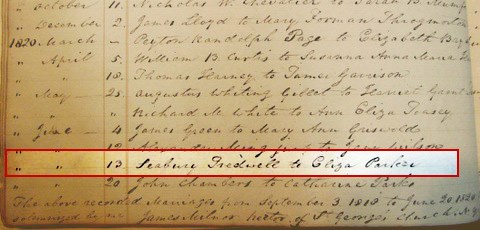
Wedding Registry, St. George’s Episcopal Church
